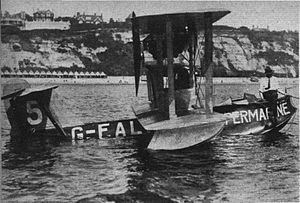Top speed 237 km/h Length 7.32 m | Wingspan 11 m | |
 | ||
The Supermarine Sea Lion I was a British racing flying boat designed and built by the Supermarine Aviation Works for the 1919 Schneider Trophy at Bournemouth, England. The later racing flying boat for the 1922 Schneider Trophy the Sea Lion II was a different design.
Contents
Development
In need for a contender for the 1919 Schneider Trophy race Supermarine developed a racing flying boat as a modification of their Baby. The Baby was a single-seat biplane fighter flying boat powered by a 450 hp (336 kW) Napier Lion engine in pusher configuration that had first flown in 1917.
Re-built as racing flying boat G-EALP was entered into the 1919 race flown by Basil Hobbs. On 10 September 1919, the aircraft struck flotsam when Hobbs took off from Swanage Bay, having landed in thick fog in order to get his bearings, and the fuselage was holed. When he alighted near Bournemouth Pier for his compulsory first lap landing the aircraft sank. The race ended in chaos due to the fog and the results were annulled.
Specifications (Sea Lion I)
Data from A.J.Jackson, British Civil Aircraft since 1919 Volume 3, Putnam & Company, London, 1974, ISBN 978-0-370-10014-2
General characteristics
Performance
